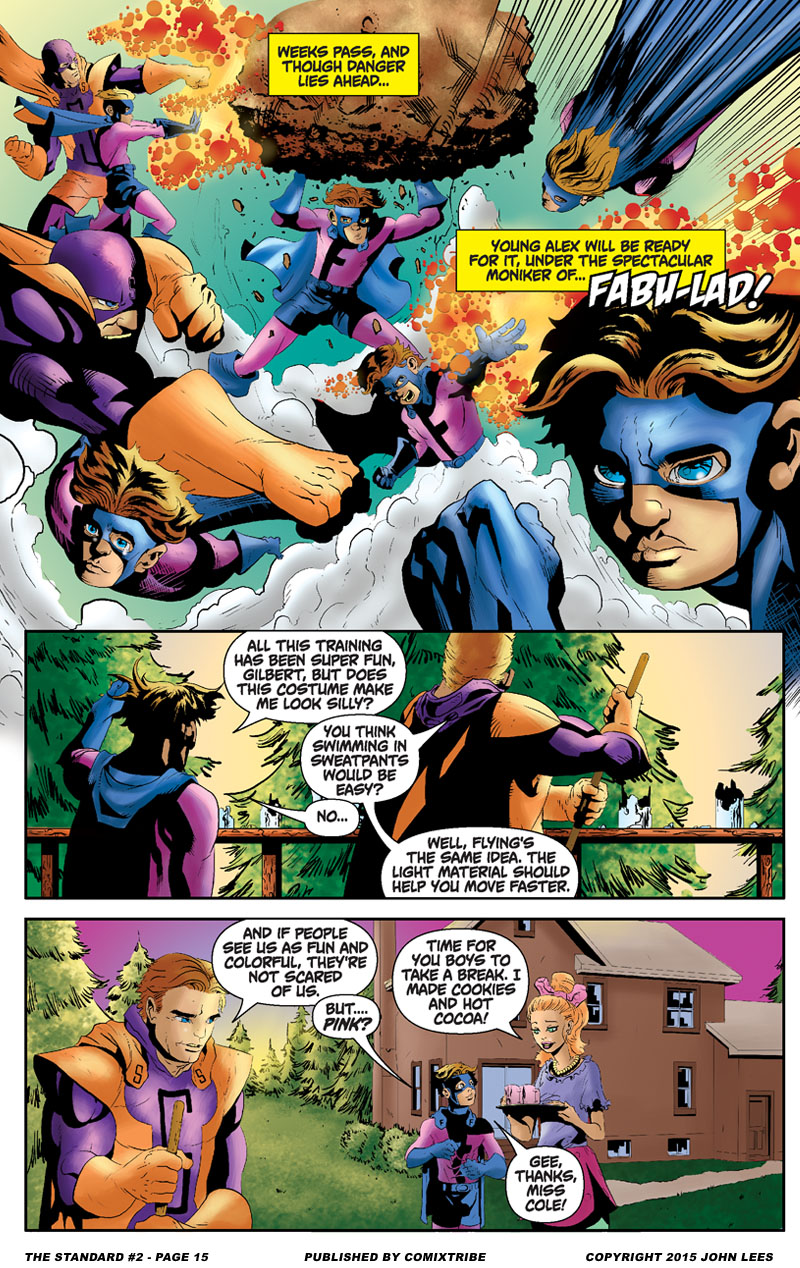I love that top panel! A really dynamic training montage with The Standard and Fabu-Lad, donning the costume for the first time. Readers with good memories may also catch a call-back to a line that the adult Alex would go on to repurpose in the present day in Chapter 1.
I remember there being some coloring issues with this page at the time, which took multiple attempts to get fixed. I think there were some issues with the color of the house, Caroline Cole’s hair and Gilbert Graham’s hair being inconsistent with how they were depicted in issue #1, and looking at the page now, even as we were rolling to press the errors weren’t fully amended. I guess it’s too easy as a creator to focus on the mistakes on a page after the fact rather than the many things done right!
Here’s another installment of the fictional history of Alex Thomas:
THE STANDARD FAN CULTURE
A few weeks ago we talked about “Standard-mania”, the media frenzy that erupted when The Standard first appeared late in 1966. That was a response based on a sense of awe, the sheer wonder of knowing that superheroes were real, and the subsequent feeling that anything was possible. But we should never underestimate humanity’s capability of taking the amazing for granted. And so nowadays, we can see how the fan culture around The Standard and other heroes has changed.
With the rise of the internet and the information age, fans from all over the world can unite to discuss Standard-related minutiae. Many fansites, forums and blogs like this one have popped up all across the internet, some of which rank among the most popular sites on the web. Even niche interests like Standard fan fiction – more on that tomorrow – are catered to. Whether it’s his TV shows, his public exploits, or in my case the history of the mantle he wears, Alex Thomas is one of the hottest talking points in the world.
But I’ve noticed this trend, not just with Alex Thomas, but with superheroes as a whole. It seems that awe and wonder is gone. We want to consume and process superheroes like we’d do with any other celebrity. And so the paparazzi follow heroes around, and the gossip mags dig up every little detail of their personal lives. Under such intense media scrutiny, it’s getting harder and harder for heroes to maintain a secret identity. Especially when media outlets will – without any thought for that person’s personal safety or the safety of their loved ones – post as a front page news expose any discovery of a name and a face behind a hero’s mask. The notorious case of gay-rights superhero Captain Rainbow being outed as Ashton Levy, a teenager living as a closeted homosexual in a deeply right-wing community, which tragically resulted in Levy’s suicide, has been forgotten all too soon.
But beyond that obvious risk, it’s the little things, the extent of the devaluation and demystification of superheroes under such a critical eye, that is also disheartening. “Is Manatee Man Getting Too Fat For Spandex?” “Is Anne Azon Pregnant?” “Are Mr. and Mrs. Fantabulous Getting Divorced?” It all just seems so petty and demeaning a fate for a group who at one point were seen as the saviours of the world.
The Standard might remain as popular as ever, if not more popular than ever, but as I said earlier in the week, Alex Thomas has changed what that popularity stems from. Now, The Standard is a brand, a merchandising giant, with all that revenue from memorabilia going to Alex Thomas and his sponsors.






Discussion ¬